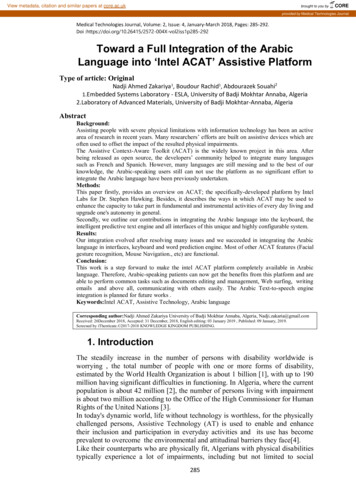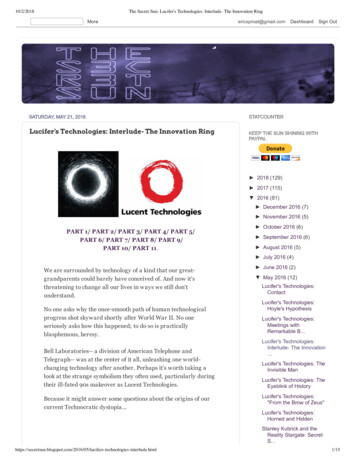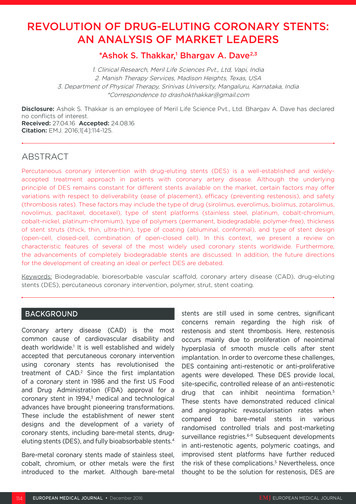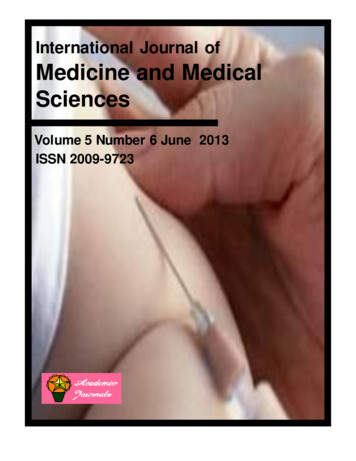
Transcription
View metadata, citation and similar papers at core.ac.ukbrought to you byCOREprovided by Medical Technologies JournalMedical Technologies Journal, Volume: 2, Issue: 4, January-March 2018, Pages: 285-292.Doi 92Toward a Full Integration of the ArabicLanguage into ‘Intel ACAT’ Assistive PlatformType of article: OriginalNadji Ahmed Zakariya1, Boudour Rachid1, Abdourazek Souahi21.Embedded Systems Laboratory - ESLA, University of Badji Mokhtar Annaba, Algeria2.Laboratory of Advanced Materials, University of Badji Mokhtar-Annaba, AlgeriaAbstractBackground:Assisting people with severe physical limitations with information technology has been an activearea of research in recent years. Many researchers’ efforts are built on assistive devices which areoften used to offset the impact of the resulted physical impairments.The Assistive Context-Aware Toolkit (ACAT) is the widely known project in this area. Afterbeing released as open source, the developers’ community helped to integrate many languagessuch as French and Spanich. However, many languages are still messing and to the best of ourknowledge, the Arabic-speaking users still can not use the platform as no significant effort tointegrate the Arabic language have been previously undertaken.Methods:This paper firstly, provides an overview on ACAT; the specifically-developed platform by IntelLabs for Dr. Stephen Hawking. Besides, it describes the ways in which ACAT may be used toenhance the capacity to take part in fundamental and instrumental activities of every day living andupgrade one's autonomy in general.Secondly, we outline our contributions in integrating the Arabic language into the keyboard, theintelligent predictive text engine and all interfaces of this unique and highly configurable system.Results:Our integration evolved after resolving many issues and we succeeded in integrating the Arabiclanguage in interfaces, keyboard and word prediction engine. Most of other ACAT features (Facialgesture recognition, Mouse Navigation., etc) are functional.Conclusion:This work is a step forward to make the intel ACAT platform completely available in Arabiclanguage. Therefore, Arabic-speaking patients can now get the benefits from this platform and areable to perform common tasks such as documents editing and management, Web surfing, writingemails and above all, communicating with others easily. The Arabic Text-to-speech engineintegration is planned for future works .Keywords:Intel ACAT, Assistive Technology, Arabic languageCorresponding author:Nadji Ahmed Zakariya University of Badji Mokhtar Annaba, Algeria, Nadji.zakaria@gmail.comReceived: 26December 2018, Accepted: 31 December, 2018, English editing: 03 January 2019 , Published: 09 January, 2019.Screened by iThenticate. 2017-2018 KNOWLEDGE KINGDOM PUBLISHING.1. IntroductionThe steadily increase in the number of persons with disability worldwide isworrying , the total number of people with one or more forms of disability,estimated by the World Health Organization is about 1 billion [1], with up to 190million having significant difficulties in functioning. In Algeria, where the currentpopulation is about 42 million [2], the number of persons living with impairmentis about two million according to the Office of the High Commissioner for HumanRights of the United Nations [3].In today's dynamic world, life without technology is worthless, for the physicallychallenged persons, Assistive Technology (AT) is used to enable and enhancetheir inclusion and participation in everyday activities and its use has becomeprevalent to overcome the environmental and attitudinal barriers they face[4].Like their counterparts who are physically fit, Algerians with physical disabilitiestypically experience a lot of impairments, including but not limited to social285
Medical Technologies Journal, Volume: 2, Issue: 4, January-March 2018, Pages: 285-292.Doi 92communication, in their behaviors; these impairments leads to poor adaptiveskills, including personal living, and community living skills [5].Since the definition of AT is “any item, piece of equipment or product that isapplied to secure, increase, maintain or improve functional capabilities” [6], ATsare often experienced as an extension of the body since they are used to improve,expand or extend people’s performances, actions and interactions.[7]As mentioned by Lancioni in his work [8]: “The AT and technology-aidedprogram required to help these individuals might involve (a) a sensor that theindividuals can activate with a small response (e.g., a finger, lip, small head, oreyelid movement) and (b) a computer or other electronic device that responds tomicro switch activations by delivering specific stimulation. The use of thistechnology aided program can provide the individuals with the necessary supportto make their small responses functional to access and control preferredenvironmental stimulation”.In the same context, in 2015, Intel has released for free, a highly configurableopen-source assistive platform called Assistive Context-Aware Toolkit (ACAT),to help people with such physical conditions to have full access to the capabilitiesand applications of their computers through very constrained interfaces suitablefor their conditions [9,10], but there’s one downside , the ACAT can be used onlyin few languages (English, Spanish, Portuguese and French).[11].Through a review of the existing literature on ACAT and after testing the platformwe intend in the first part of this work, to outline its applications and how it maybe used to increase independence, improve personal productivity, enhance thequality of patient’s life, and identify current barriers to its effective integration inthe Algerian context with an accentuation on empowering Arabic-speakingpatients to end up autonomous and gainful individuals from standard society. Inthe second part, we present the preliminary contribution of the authors, whichconsists of expanding the Intel ACAT platform and make it useable for Arabicspeaking paralyzed people by integrating the Arabic language into the keyboard,the intelligent predictive text engine and all of its interfaces.2. MotivationAccessible and moderate AT access for all individuals has been cherished as ahuman right inside the United Nations Convention on the Rights of Persons withDisabilities [12], however significant unmet and under met need for AT exists[13]. The World Report on Disability appraises that just 1 out of 10 individualsapproach AT: a shortage for more than 1 billion individuals [1].Thus, in Algeria like elsewhere, individuals with handicaps, might be not able tohave any contact with their direct environment. Setting up such contact andcreating essential types of control of favored natural incitement would rely uponthe possibility of using their minimal response repertoire [8,14].3. Overview on Intel ACATThe huge quantity of assistive products and related services is increasingexponentially as a result of technological developments. The challenge is not onlyto inform people about their existence, yet in addition about their quality,convenience, adequacy and availability. Moreover, it ideally should beunbiased/autonomous (not impacted by business or different interests) andbolstered by research proof and depends on client encounters and needs [15].286
Medical Technologies Journal, Volume: 2, Issue: 4, January-March 2018, Pages: 285-292.Doi 92Based on the above mentioned criteria, and according to [9] and [10], we foundthat ACAT is the most suitable Assistive device for Algerian disabled people withlow or no income.In fact, ACAT is an open source platform developed by researchers at Intel Labsto help Professor Hawking, who had amyotrophic lateral sclerosis (ALS)communicate by translating his facial movements into text. ACAT is organized asa modular system; the ACAT Core library and the ACAT Extension library giveall of the ACAT’s core functionalities, such as text-to-speech module, wordprediction and input switch trigger handling. Applications interaction withextensions is over well-defined interfaces. Extensions raise events to notifysubscribers when something interesting happens [11]. The ACAT Resourcelibrary handles localization of ACAT in different languages. See Figure 1.Figure 1: ACAT core componentsBy sharing this platform with the public, Intel hopes developers will expand itsapplication to a wider range of disabilities by adding new sensing modalities, newuser interfaces (UI), word prediction and many other features to assist incommunicating via text or software command[11] , More details on ACAT and itsprincipal components can be found in [10], [11].In Algeria, the Intel assistive platform ACAT can be used in foreign languagesonly, mainly in French or English. The Arabic-speaking users, who represent themajority of the patients, still unfortunately cannot use the platform.The system works as intended and seems very promising for the Algerian Contextas it was for other countries where tested before.4. Integration of the Arabic languageAs detailed in the previous section, the ACAT platform is helpful for researchersand engeeiners who are keen on creating assistive advances to individuals withinabilities not with standing specialists who are taking a shot at new user287
Medical Technologies Journal, Volume: 2, Issue: 4, January-March 2018, Pages: 285-292.Doi 92interfaces, new detecting modalities or word prediction and needing to investigatethese developments in the community [11].The availability of the platform in only few languages proves limited for Algerianusers. Thus, in order to bridge this gap we took the initiative to make the platformavailable in Arabic. This part describes the different steps including (a)creating/integrating Menus, Keyboard, all interfaces (b) configuring Scanning(The process of selecting by highlighting), then (c) creating the database ofprediction engine.Interfaces and menusIn the first place, we created Arabic Interfaces and Menus; we followed theACAT developer’s guideline [16]. The code is entirely written in C#, using Visual2012 and Microsoft .NET Framework 4.5. Then we had to create an Arabiclibrary of all words and strings used in interfaces, dialogs and menus (about 400words), the library is named ACATResources.ar.resx, see Figure 2.Figure 2: Example of Settings menu and General settings dialog in ArabicKeyboardThereafter, we integrated the Arabic into the visual keyboard. It’s worthmentioning that the Arabic alphabet contains more letters than the English one butin Arabic there are no capital letters. Thus, several methods can be used toimplement the alphabet in ACAT. One can add rows or columns, or just add someletters as capitals of others. We choose to add more buttons instead of using theshift button, see Figure 3.288
Medical Technologies Journal, Volume: 2, Issue: 4, January-March 2018, Pages: 285-292.Doi 92Figure 3: Arabic Keyboard; 1st configurationWe had also to configure the Alphabet scanner for this new keyboard to enablethe text entry. All other scanners (for cursor navigation, selecting, etc.) remain thesame.Word predictionPresage, the intelligent predictive text engine created by Matteo Vescovi, drivesACAT 's Word Prediction module[17]. It provides prediction results based on thecontext for auto-completion or next-word. Prediction results are returned in thelanguage that is currently active. The results are obtained by looking up a wordprediction database that is created from source texts in that language. For moreinformation see [18].For the integration of the Arabic language for our case, an Arabic database wasbuilt using "text2ngram" tool [19].5. ResultsThe integration of Arabic language (except Text-to-speech) into the ACATplatform was difficult but successful. It offered a new opportunity for arabicspeacking users to get the benefit from Intel ACAT more conveniently. It canaddress their various needs, such as expanding socialization, independence andleisure options. They can now communicate, navigate the web and understand allthe features offered by ACAT see Figure 4 and Figure 5.289
Medical Technologies Journal, Volume: 2, Issue: 4, January-March 2018, Pages: 285-292.Doi 92Figure 4: Testing Facial gesture recognition after the integrationFigure 5: Browsing the internet over Facial gesture recognition under ACAT6. DiscussionThe intelligent predictive text engine will improve the Arabic database byautomatically learning new words based on the patient context.For the keyboard part, as mentioned before, several methods of implementationare possible. We can add a dialog to permit the user to choose one of them as perindividual preferences. Diacritics could also be added in the keyboard in Arabic.One diacritic can change the whole meaning of the sentence. We recognize theneed of new research and efforts to provide the ACAT platform for otheroperating systems (ACAT runs only on Microsoft Windows).7. ConclusionsAfter reporting the potentials offered by the Intel ACAT platform to enhance thepersonal autonomy and quality of life for people with acute disabilities, the290
Medical Technologies Journal, Volume: 2, Issue: 4, January-March 2018, Pages: 285-292.Doi 92barriers to its implementation and adoption in the Algerian context were found toinclude primarily the unavailibility of the platform in the Arabic language.In order to cross this barrier, we integrated partially the Arabic language into theACAT platform and discussed some of the faced integration issues.This integration would make a real difference for Arabic-speaking patients byhelping these 'locked-in' individuals in daily tasks such as communicating withothers, navigating the Intenet and access to information.This work will also provide researchers with an arabic interface to createcustomized solutions as per patient needs and preferences in term of keyborad andword and sentence prediction with diacritics.We plan to make the plateform fully suitable for Arabic-speaking patients infuture works and we intend to customize it further for the Algerian population andtest it intensively.8. Conflict of interest statementAuthors declare no conflicts of interest.9. Authors biographyNo biography10.References[1] Algeria Population 2018 [Internet].Walnut : World Population Review ; c2018 Available geria-population/ [cited 2018 Sep 21].[2] Committee on the Rights of Persons with Disabilities reviews the report of Algeria [Internet].Geneva:UN Human Rights; c1996-2018.Available from: https://www.ohchr.org [cited 2018 Sep13][3] WHO.World report on disability: World Health Organization; 2011.[4] Alexandra D, Lorenzo C. A multidisciplinary approach for developing an assessment tool fortouch screen devices, Disability and Rehabilitation: Assistive Technology, 2017. DOI:10.1080/17483107.2017.1370500[5] Loomis JW. Supporting adult independence in the community for individuals with highfunctioning autism spectrum disorders.In: Volkmar FR, Rogers SJ, Paul R, Pelphrey KA,editors.Handbook of autism and pervasive developmental disorders.Vol. 2, 4th ed. Hoboken (NJ):John Wiley & Sons; 2014. p. utc41[6] Wielandt, T, McKenna K, Tooth, L,Strong, J. Factors that predict the postcharge use ofrecommended assistive technology (AT). Disability & Rehabilitation: Assistive Technology, 20061(1–2): 29–40.https://doi.org/10.1080/09638280500167159 PMid:19256165[7] Lupton D, Seymour W, Technology, selfhood and physical disability. Social Science &Medicine, 2000 50(12): 1851–1862. https://doi.org/10.1016/S0277-9536(99)00422-0[8] Giulio E. Lancioni. "Assistive Technology Programs to Support Persons withNeurodevelopmental Disorders", Advances in Neurodevelopmental Disorders, 2018. p. 1-2.PMid:29787790[9] Pete Denman, Lama Nachman, and Sai Prasad.Designing for "a" user: Stephen Hawking's UI.In Proceedings of the 14th Participatory Design Conference: Short Papers, Interactive Exhibitions,Workshops - Volume 2 (PDC '16), Claus Bossen, Rachel Charlotte Smith, Anne Marie Kanstrup,Janet McDonnell, Maurizio Teli, and KeldBødker (Eds.), Vol. 2. ACM, New York, NY, USA, 9495. 2016 DOI: https://doi.org/10.1145/2948076.2948112[10] Felipe P. Assistive Context-Aware Toolkit, The Developer's Conference - [Internet].FlorianópolisBrasil. 2016. Available from: https://www.slideshare.net/felipe pedroso/assistivecontextaware-toolkit-english [cited 2018 Sep 21].291
Medical Technologies Journal, Volume: 2, Issue: 4, January-March 2018, Pages: 285-292.Doi 92[11] Assistive Context-Aware Toolkit (ACAT), Project01 [Internet]. Intel's Open SourceTechnology Center of open source c2018 Intel Corporation; Available from: https://www.01.org/acat [cited 2018 Sep 10][12] United Nations.Convention on the rights of persons with disabilities and optional protocol.Geneva: United Nations; 2006.[13] World Health Organization. WHO global disability action plan 2014–2021. Geneva: WorldHealth Organization; 2015.[14] Rohwerder, B. Disability in North Africa.K4D Helpdesk Report. Brighton, UK: Institute ofDevelopment Studies,2018 PMCid:PMC5870151[15] Luc D, Emily S, Shivani G, Vinicius D, Uta R. Assistive technology provision: towards aninternational framework for assuring availability and accessibility of affordable high-qualityassistive technology, Disability and Rehabilitation: Assistive Technology, 2018,13:5, 467472,DOI: 10.1080/17483107.2018.1470264[16] Sai Prasad. ACAT Developer's Guide [Internet]. Intel's Open Source Technology Center fault/files/documentation/acat developers guide 2.pdf [cited 2018 Sep 10][17] Matteo V, Presage: The intelligent predictive text entry system [Internet]. University ofEdinburgh uk; Available from: http://presage.sourceforge.net [cited 2018 Sep 21].[18] Sai P. ACAT Source Code [Internet]. Hillsboro c2013-15 Intel Corporation; Available from:https://github.com/01org/acat/ [cited 2018 Sep 10][19] Le Z. N-Gram Extraction Tools [Internet]. University of Edinburgh. Available html [cited 2018 Sep 21]292
The Assistive Context-Aware Toolkit (ACAT) is the widely known project in this area. After being released as open source, the developers' community helped to integrate many languages such as French and Spanich. However, many languages are still messing and to the best of our











